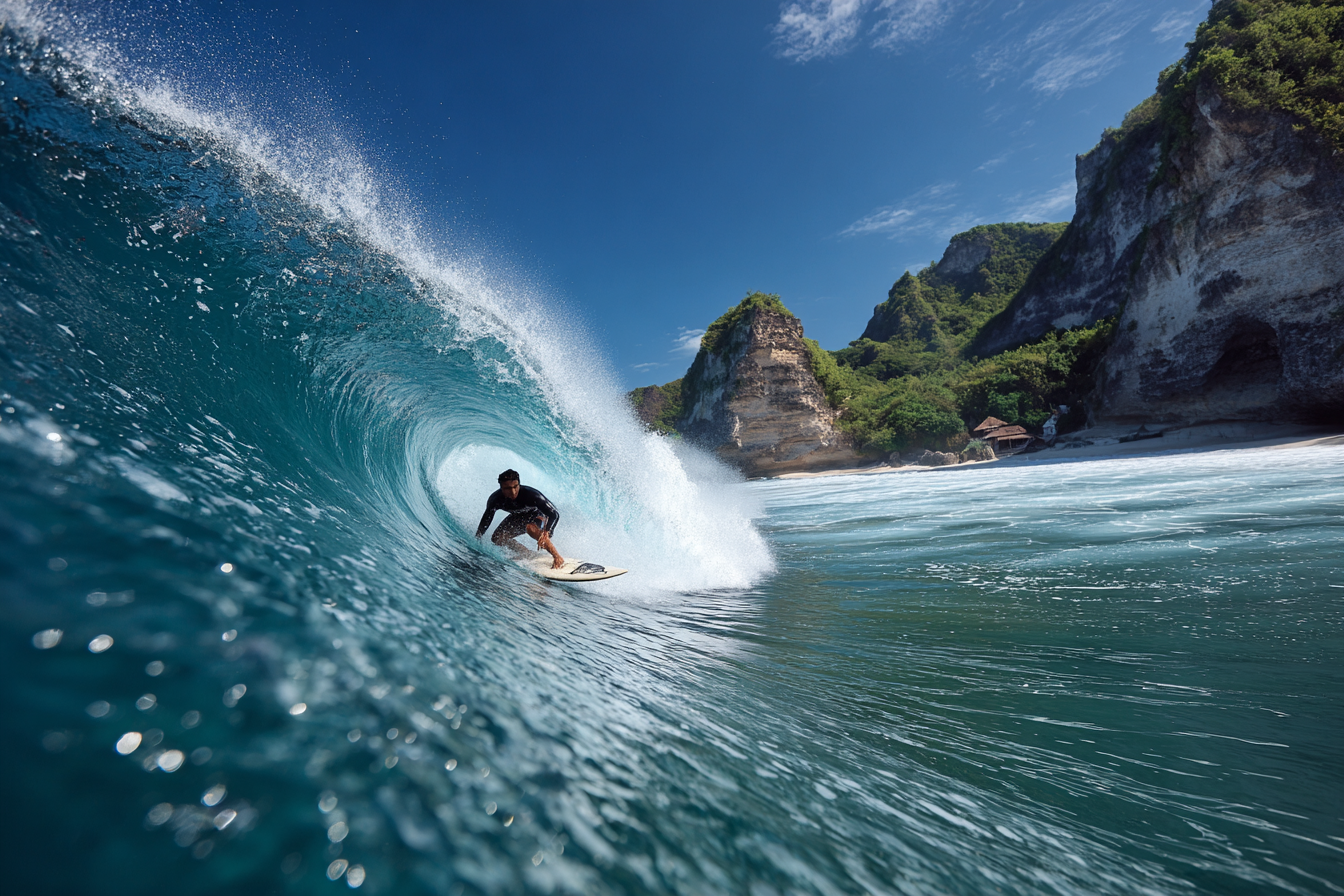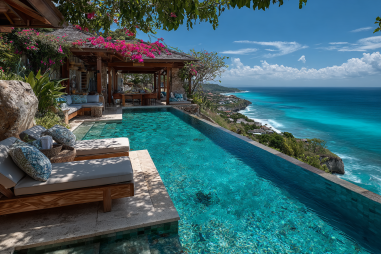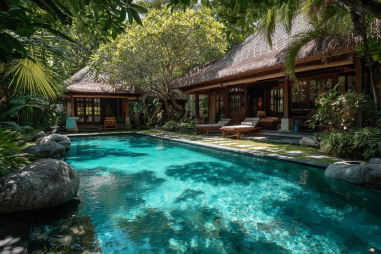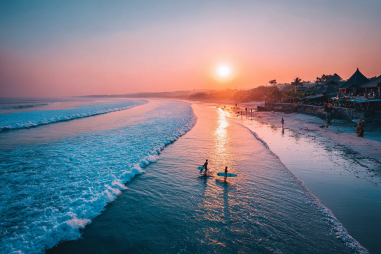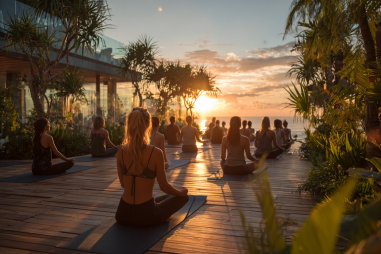Uluwatu, perched on the southern tip of Bali’s Bukit Peninsula, is legendary among surfers worldwide. Known for its dramatic cliffs, crystal-clear waters, and world-class waves rolling in over pristine reefs, Uluwatu offers an unforgettable surfing experience for adventurers of all skill levels. Whether you’ve seen those iconic surf videos or are simply dreaming of catching your first big wave, Uluwatu’s surfing spots provide the perfect setting to make those dreams come true. This guide will introduce you to Uluwatu’s prime surf breaks, share tips on the best times to visit, offer advice on equipment and lessons, and dive into the vibrant local surf culture that makes this area truly special.
Overview of Uluwatu’s Key Surf Breaks
Uluwatu is not just a single surf spot but a collection of remarkable breaks along the coast, each with its own unique characteristics. The area’s waves are primarily reef breaks, known for their powerful, hollow, and fast-breaking nature, which provide some of Bali’s most thrilling rides. Here are some standout locations:
- Uluwatu Main Peak: This iconic wave is world-renowned for its long, challenging rides and perfectly peeling waves. It breaks both left and right but is most famous for its lefts that wrap around the reef. This spot generally suits intermediate to advanced surfers due to the powerful surf and sharp reef.
- Padang Padang: Just a stone’s throw from Uluwatu, this spot is famous for its powerful barrel waves and gained international fame through contests and surf films. It’s sometimes called the “Balinese Pipeline” and is more suited for experienced surfers because of its hollow and fast waves.
- Bingin Beach: Known for its beautiful white sand and consistent waves, Bingin offers fast, hollow waves that break over coral reefs. Intermediate surfers can have a fantastic time here, especially when the swell begins to line up properly.
- Impossible: This spot earns its name from the incredibly fast and thick waves that break here. Advanced surfers flock to Impossible for the challenge of riding its powerful barrels.
- Racetracks: True to its name, Racetracks produces speedy, challenging waves perfect for more experienced surfers who love a fast, adrenaline-pumping ride.
Surf Spots for Every Skill Level
One of the best things about Uluwatu is that it caters to surfers across different abilities. If you’re a beginner, some spots are more forgiving and offer a great environment to learn and improve without the intimidating reef breaks found at more advanced waves.
- Beginners: While Uluwatu’s main breaks can be challenging, nearby beaches like Suluban Beach and Dreamland provide gentler waves suitable for novices. These sandy-bottomed areas help beginners practice fundamental surfing techniques with less risk of injury from sharp coral.
- Intermediate Surfers: Bingin Beach and Padang Padang’s outside reef breaks present waves that will push intermediate surfers to advance their skills, offering faster rides and some barrels without being overly intimidating.
- Advanced Surfers: Uluwatu’s main peak, Impossible, and Racetracks demand high skill levels, expert timing, and excellent wave knowledge. These spots reward experienced surfers with thrilling barrels, lengthy rides, and the chance to ride some of Bali’s finest waves.
Ideal Seasons and Tide Conditions
Timing your trip for the best waves is crucial in Uluwatu. Bali’s surf season is primarily dictated by the dry season, which runs from April to October. During this period, consistent swells come from the Indian Ocean, producing clean offshore winds and manageable waves that break beautifully on Uluwatu’s coral reefs.
The highest swell activity typically occurs between June and August, but waves during this time can be quite powerful. Beginners might prefer the shoulder months of April, May, and September when conditions tend to be a bit mellower.
Tides also play an important role in wave quality and safety. Low to mid tides generally offer the best surf because the reef is more exposed, helping the waves to break cleanly. High tides can make some breaks less desirable or even dangerous, as the waves become less predictable. For beginners, it’s safer to surf during mid to high tide when the waves are less sharp and the reef is less exposed. It’s always good to check local tide charts before heading out.
Renting Surfboards and Taking Lessons
If you’re not bringing your own surfboard, Uluwatu has no shortage of rental shops offering everything from beginner foam boards to high-performance shortboards. Prices vary based on board type and rental duration, but expect to pay around $5 to $15 per day. Many rental places also provide wetsuits or rash guards, which can protect against reef rash and sun exposure.
For beginners or those looking to sharpen their skills, surf lessons are widely available. Local instructors are knowledgeable about the surf conditions and breaks and can provide personalized guidance for a safe and enjoyable surfing experience. Group lessons are perfect for a fun introduction, while private lessons allow for more tailored attention and quicker progression. Many instructors also combine lessons with safety tips and paddling techniques to ensure you get the most out of your session.
The Local Surfing Culture
Surfing in Uluwatu is more than just a sport; it’s a way of life deeply ingrained in the local community. The area is home to a mix of local Balinese surfers and international visitors who share a mutual respect for the ocean and the waves. Hospitality is central to the culture, and it’s common to see surfers greeting each other with friendly nods or smiles before hitting the water.
Many locals uphold traditional values and conservation efforts, emphasizing sustainable tourism to protect the environment that supports their livelihoods. Respecting the lineup etiquette is crucial — this means waiting your turn, not dropping in on others, and being aware of each other’s safety. This respectful attitude helps maintain harmony between surfers and locals, enhancing the overall experience.
Safety and Environmental Considerations
While Uluwatu offers some of the best waves, safety should always be a priority, especially given the rocky reefs and powerful waves. Here are some essential safety tips:
- Always check surf conditions and weather forecasts before paddling out.
- Know your limits—if the waves look too challenging, consider surfing a gentler spot or taking a lesson.
- Wear reef-safe footwear or rash guards to avoid cuts and scrapes from sharp corals.
- Beware of strong currents and undertows, particularly around the reef edges.
- Surf with a buddy whenever possible and let someone know your plans.
Regarding the environment, Uluwatu’s coral reefs and marine life are fragile ecosystems. Practicing eco-friendly habits helps preserve the area for future surfers:
- Use reef-safe sunscreen to minimize chemical impact on marine life.
- Avoid touching or stepping on corals as they are living organisms sensitive to damage.
- Dispose of all trash properly and participate in local beach clean-ups if possible.
- Support local businesses and initiatives focused on sustainable tourism.
Events and Surfing Festivals in Uluwatu
Beyond daily surfing pleasures, Uluwatu hosts some exciting surfing festivals and competitions that draw global attention. These events feature top professional surfers showcasing their skills in incredible waves and are a thrilling spectacle for visitors.
One example is the annual Uluwatu Surf Festival, which includes contests, workshops, and community events that celebrate surfing culture, environmental awareness, and local art. Attending such festivals is a wonderful way to immerse yourself in the vibrant surf scene and connect with fellow surf enthusiasts from around the world.
Additionally, smaller local competitions occur year-round, often providing opportunities for up-and-coming Indonesian surfers to make their mark. Whether you’re competing or spectating, these events add an extra layer of excitement to the Uluwatu surf experience.
Whether you’re seeking adrenaline-pumping barrels or just aiming to enjoy the stunning beauty of Bali’s waves, Uluwatu is an unmatched destination for surfers of all levels. By understanding its diverse surf breaks, respecting local culture, and prioritizing safety and sustainability, you can make your time here truly memorable. So wax your board, pack your spirit of adventure, and get ready to catch the perfect wave in this surfer’s paradise.

